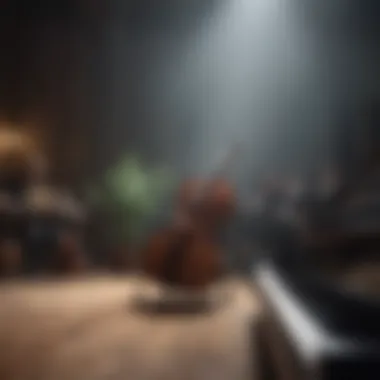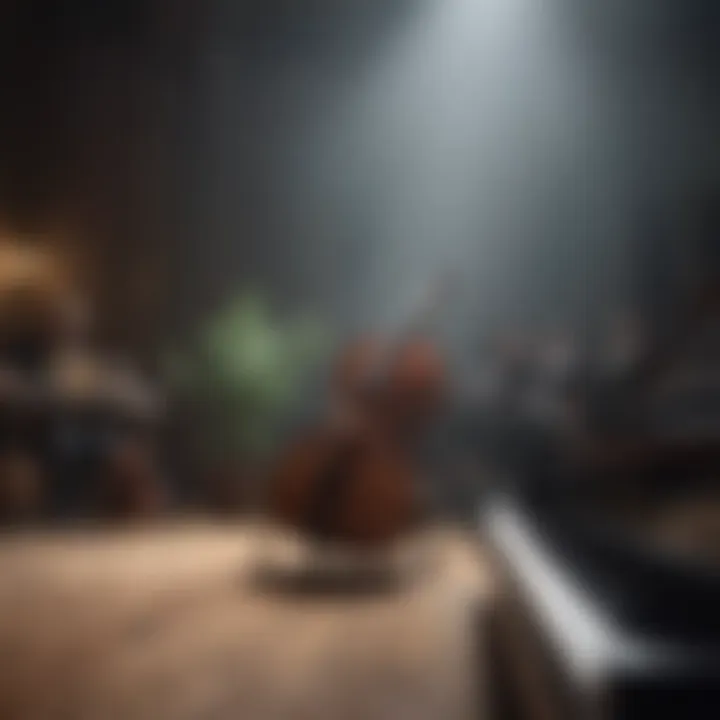Exploring the Depths of Quiet Classical Music


Intro
Quiet classical music occupies a unique niche in the vast landscape of musical expression. Unlike its more boisterous counterparts, this genre emphasizes subtlety and serenity. It invites listeners to slow down and engage with its delicate nuances. From the soft whispers of the piano to the gentle caress of strings, quiet classical music resonates deeply with emotional and psychological themes that often go unnoticed.
In the following sections, we will delve into the artists who have shaped this realm, examine their unique styles, and uncover the intricacies of compositions that prioritize restraint over bombast. We’ll explore how this music has influenced listeners, eased stress, and influenced therapeutic practices, standing as a testament to the power of quietude in a noisy world.
Artist Profile
Biography and Background
Many composers attributed to quiet classical music have traversed varying paths in their personal and professional lives. Take Erik Satie, for instance. Born in 1866, Satie's life was marked by a blend of eccentricity and simplicity. Known for his quirky habits, such as writing furniture music meant to be played quietly in the background, Satie embodied the art of subtlety. His compositions often reflect mundane themes but resonate with profound emotional depth.
Another significant figure is Frédéric Chopin. While often celebrated for his passionate nocturnes and ballades, Chopin’s Préludes exemplify the beauty found in simplicity. His early life in Poland introduced him to a world of folk music, which later influenced the delicate structure of his works. Each note and phrase chosen by Chopin seems deliberate in crafting atmosphere and feeling.
Major Influences and Inspirations
In quiet classical music, influences and inspirations abound, shaping its character across different eras. Satie, for example, drew primarily from French Romanticism, yet also eyed the Impressionist movement, creating a tapestry of sound that seeks to evoke imagery without defined edges. Similarly, Chopin was heavily influenced by Polish folk traditions as well as the sounds of Beethoven and Bach, who cultivated his delicate sensibilities.
Moreover, the ambient quality of nature often acts as a muse for these artists. Such influences are evident in compositions that incorporate silence as a fundamental element, allowing the listener's imagination to run wild. Instrumental music splendidly illustrates the power of suggestion, as melodies intertwine with silence, creating a sonic canvas as rich as it is understated.
Song Analysis
Theme and Lyrics Breakdown
While quiet classical music often lacks lyrics, the themes it conveys are rich and multifaceted. Take Satie's Gymnopédies, for instance. These pieces explore themes of nostalgia and introspection, using simple harmonic structures to evoke deep feelings. Each chord strikes aesthetic beauty and emotional resonance without overwhelming the listener.
Chopin's Nocturne in E-flat major, Op. 9 No. 2, embodies a similar softness, drawing upon themes of longing and romance. Its lyrical nature and flowing lines make it a cherished example of the intimacy and emotional transparency that define the genre.
Instrumentation and Composition
The instrumentation in quiet classical music plays a crucial role in shaping its enveloping atmosphere. The choice of instruments often leads to an understated texture that communicates deep feeling.
For instance, piano and string ensembles frequently dominate this style, characterized by delicate arpeggios and soft dynamics.
- Piano: The piano's versatility allows composers like Chopin and Satie to create intricate layers while still maintaining a sense of calmness.
- Strings: Violin and cello often express lingering emotions, with their capacity for expressive phrasing and warm, resonant sound.
Quiet classical pieces also involve meticulous composition techniques, using silence not just as a void but as an integral part of the musical narrative. The careful balance of sound and silence nurtures a meditative experience that encourages listeners to reflect inwardly, feeling the weight of each note.
"In music, silence is more than absence of sound; it is the foundation for creating emotional depth."
The study of quiet classical music not only enhances one’s understanding of the genre but also enriches personal experiences with music, fostering a deeper appreciation for its serene beauty.
As we move forward, we will explore the therapeutic benefits and broader cultural implications of this often-overlooked aspect of classical music.
Preamble to Quiet Classical Music
Quiet classical music serves as a gentle balm to the often chaotic rhythm of modern life. It draws listeners into a space where subtlety reigns, inviting reflection and introspection. This musical form, with its soft nuances and understated melodies, is not merely a backdrop but rather an art that engages the listener in profound ways. It is essential to understand this genre not just in its historical context but also through its emotional and cognitive influence.
Through a deep exploration into quiet classical music, we unravel its significance in both personal and cultural landscapes. For music enthusiasts, aspiring musicians, and students, knowing about this genre enhances appreciation and opens up avenues for further exploration. The elegance and depth of quiet classical music resonate with timeless truths about human experience, weaving through emotions like a soft whisper in the night.
Defining Quiet Classical Music
When we talk about quiet classical music, we refer to compositions that prioritize subtlety and nuance over grandiosity. This definition doesn't confine it to volume alone; rather, it encompasses the intention behind the music. These pieces often harness stillness as a canvas on which emotions can bloom, inviting listeners to immerse themselves in a world of delicate sounds. It is a genre where silence speaks as much as sound, often leading to a heightened awareness of musical textures.
Quiet classical music is where dynamics play a crucial role, often operating in the softer range of the spectrum. While not concluding them to be trivial, these pieces create space for listeners to interact and connect with their own emotions, transforming personal reflection into a shared experience through music. Think of it as a gentle hug for the soul, soft but undeniably present.


Characteristics of the Genre
Quiet classical music embodies distinct characteristics that set it apart from its more vigorous counterparts. These nuances can be appreciated through various elements:
- Dynamics: The volume levels are generally soft, with many compositions relying on subtle crescendos and decrescendos to evoke emotion.
- Melodic Simplicity: Often, the melodies are straightforward yet beautifully expressive, allowing listeners to engage without feeling overwhelmed.
- Textural Richness: Even in the absence of grand orchestras, quiet classical music showcases a layered musicality. Instrumentation often involves piano, strings, and woodwinds, each contributing to a harmonious web of sound.
- Rhythmic Ease: The tempo tends to be slower and more relaxed, allowing listeners to savor the music rather than rush through it.
- Emotional Depth: Importantly, quiet music can evoke various feelings, from tranquility and nostalgia to longing and sorrow, proving that power does not need to be loud.
"In the silence, one discovers the music of the heart—an echo of the soul's deepest desires."
These characteristics shape the very essence of what many might consider a lesser-known genre, but one that impacts listeners on numerous levels, forging connections between the music and the human experience.
Historical Context
The historical context of quiet classical music involves understanding its roots and evolution, providing an enriching backdrop for appreciating its subtle intricacies. This genre doesn't just emerge from a vacuum; it is deeply intertwined with various cultural, social, and artistic movements across centuries. By exploring the origins and the evolution of understated compositions, we can grasp how quietness became a powerful language of expression in music, resonating deeply with listeners throughout history.
Origins of Classical Music
Classical music, as we recognize it today, has its roots in the medieval period, around the 9th century. Various elements like Gregorian chants and early polyphony laid the groundwork for future development. However, it wasn't until the Renaissance, which marked a shift towards more complex structures in harmony and counterpoint, that classical music began to flourish in a way that would affect quieter pieces. Composers like Josquin des Prez began to explore the depths of musical expression, balancing loud and soft passages with remarkable skill.
In the Baroque era, figures like Johann Sebastian Bach brought intricate melodies and harmonies into the fold. Yet, the element of subtlety was still evolving, often overshadowed by grand compositions. This tension between grandeur and nuance remains a key factor in the narrative of classical music.
The Development of Understated Composition
The journey towards quiet classical music continued into the Classical and Romantic periods, where composers like Wolfgang Amadeus Mozart and Franz Schubert began to leverage the power of silence and soft dynamics. The contrast became vital in conveying emotions, and this is where a transition occurs. Compositions were no longer merely loud declarations; they became conversations of whispers and shouts, intricacies and simplicities.
Later, in the late 19th and early 20th centuries, composers such as Erik Satie and Claude Debussy made significant strides in this evolution. Their works did not seek to impress with grandiosity but rather to evoke a spectrum of emotions through minimalistic, gentle melodies. Satie's 'Gymnopédies,' for instance, illustrates how a soft touch can carry profound weight. Quiet classical music emerges as a canvas where emotion is painted with whispers rather than shouts, allowing listeners to engage in a deeper, more intimate experience with the music.
Ultimately, understanding the historical context of quiet classical music sheds light on why these subtle compositions are not just an amalgamation of notes, but essential pieces of an intricate cultural fabric. It highlights not just the evolution of music as art but also its significance in emotional expression across time.
"The quieter you become, the more you can hear." — Ram Dass
This phrase underlines an important aspect of quiet classical music; it draws us into a space of reflection where silence often speaks louder than words.
Notable Composers
When discussing the subtle intricacies of quiet classical music, it’s impossible to overlook the composers who shaped this serene genre. Their contributions not only define the soundscape of quiet classical pieces but also enrich our understanding of music as a medium of expression. Notable composers in this realm showcase a mastery of melody and emotion, deftly weaving tranquility into their works.
Frédéric Chopin
Frédéric Chopin, often regarded as one of the greatest composers for the piano, left an indelible mark with his Nocturnes and Etudes. His ability to draw out deep emotional responses through delicate phrasing and nuanced dynamics speaks volumes of his skill. Unlike many of his contemporaries, who favored grandeur, Chopin went for intimacy. His works are generally less about bombast and more about personal reflection.
Chopin's Nocturne in E-flat major, Op. 9 No. 2 exemplifies this quiet strength; it meanders through gentle, flowing lines that evoke a sense of longing and nostalgia. The use of rubato allows performers to stretch time itself, pulling listeners into a world that feels both personal and universal.
"Music should be like a good friend, soothing yet profound. It’s Chopin’s soft whisper that draws me in each time I listen."
Chopin, often referred to as the ‘poet of the piano,’ shows us that quieter music can stir profound feelings while maintaining a sense of restraint, crafting a delicate balance between passion and peace.
Claude Debussy
Claude Debussy pioneered the impressionist movement in music, bringing a distinctive style that thrives on subtlety and atmosphere. His piece Clair de Lune is perhaps one of the most celebrated examples of quiet classical music. With its ethereal melodies and gentle progressions, Debussy transports the listener to a calm, moonlit night.
His approach often delineates the fine line between silence and sound, using innovative harmonic structures to create a floating quality. Debussy's work invites participation from the listener, encouraging them to engage with their own emotions and thoughts. Through his expansive chords, the languorous ebb and flow in his pieces incites contemplation and introspection. Debussy exemplifies how quiet music can evoke vivid imagery and rich emotional landscapes without ever raising its voice.
Erik Satie
Erik Satie was a true avant-garde figure whose compositions reflect a playful yet introspective demeanor. Known for his Gymnopédies, Satie's music lies comfortably in the realm of gentleness and minimalism. The simplicity of these pieces is deceptive, often requiring a depth of emotion to fully appreciate their beauty. Satie believed in the essence of focusing on the moment rather than creating elaborate structures.


His piece Gymnopédie No. 1 embodies tranquility with its soothing harmonic progressions that feel almost like gentle breaths. Satie’s music challenges listeners to perceive beauty in simplicity, encouraging a meditative experience rather than a dramatic one. His style champions quietude, emphasizing stillness as a source of discovery and reflection.
These composers have shaped the landscape of quiet classical music in unique ways, each contributing their own philosophy and style. Whether through Chopin’s romantic touch, Debussy’s impressionistic nuances, or Satie's minimalism, they remind us that profound emotional experiences can often be found in the softest of expressions.
Key Compositions
The beauty of quiet classical music often lies in its ability to evoke emotions without resorting to bombastic displays. Each composition is carefully crafted, utilizing simplicity to convey complex feelings. The nuances in dynamics and articulation invite listeners to engage in a contemplative journey, allowing personal interpretation and introspection. This experience can be greatly enriching for music enthusiasts, aspiring musicians, and students alike, who seek to grasp the depth behind these serene sounds.
Chopin's Nocturnes
Frédéric Chopin's nocturnes epitomize the essence of quiet classical music. Composed primarily for solo piano, these lyrical pieces are characterized by their smooth melodic lines and rich harmonic textures. Each nocturne reveals a deep emotional landscape, often reflecting Chopin's own experiences of love, longing, and melancholy.
For example, the Nocturne in E-flat Major, Op. 9 No. 2 is celebrated for its flowing melody and delicate inner voices. The downward motion of the music gives a feeling of both tranquility and yearning, encouraging listeners to explore their own feelings through the music. The beauty of Chopin's nocturnes is not merely in their sound but also in how they allow the audience to immerse themselves in their own thoughts.
"Chopin’s nocturnes carry the listener on a journey of profound emotional depth, revealing the significance of stillness in musical expression."
Debussy's Clair de Lune
Clair de Lune, a piece from Debussy's Suite Bergamasque, showcases the intricate interplay between tension and release typical of quiet classical music. This work, infused with luminous harmonies and gentle rhythms, captures the delicate essence of moonlight—a fitting title indeed. The fluidity of its phrases creates an ethereal experience, drawing the listener into a state of tranquil awe.
The way Debussy paints auditory imagery through his use of soft dynamics and subtle shifts in tempo is nothing short of stunning. Moods shift effortlessly within the piece, sometimes echoing joy, at other times reflecting sorrow. This duality provides a rich listening experience that engages one's imagination, making it a staple in both concert repertoire and film scores alike, often used to evoke reflective moments in storytelling.
Satie's Gymnopédies
Erik Satie's Gymnopédies serve as a perfect illustration of how minimalism can yield profound impact. With their sparse melodies and unconventional chord progressions, these pieces tread lightly yet emanate an air of mystery. The first Gymnopédie, in particular, rests on a simple yet enchanting melodic line, creating an atmosphere that is both calm and contemplative.
Satie's work invites listeners to embrace silence and space. The deliberate pacing allows thoughts to flow freely without the courage of a performer demanding attention. This aspect makes Gymnopédies a popular choice for therapy and meditation environments, as they encourage relaxation and emotional release.
In examining these key compositions, listeners begin to grasp the intricate dance between sound and silence; the delicate art of quiet classical music. Each piece stands as a testament to how simplicity can convey the depth of human experience while enriching our understanding of emotion and creativity.
Emotional and Cognitive Impact
Quiet classical music holds a unique position in the realm of auditory experiences. It's more than just a collection of soothing melodies; it serves as a profound tool for emotional and cognitive engagement. This section addresses the significance of this genre on human emotions and mental processes, while shedding light on its manifold advantages.
The Psychology of Listening
The atmosphere created by quiet classical music can be likened to a gentle breeze that sweeps through one's mind, easing tense thoughts and creating space for reflection. When people settle down to listen, various psychological aspects come into play. The brain responds to music not only on an emotional level but also neurologically, releasing neurotransmitters like dopamine that enhance feelings of pleasure and relaxation.
In quiet moments with compositions by artists such as Frédéric Chopin or Erik Satie, the listener's attention shifts inward. These pieces often evoke introspection, prompting thoughts and memories to surface, which can lead to a deeper understanding of oneself. When the sonorous notes intertwine softly, an almost meditative state can settle in, aiding in mental clarity and emotional balance.
Some studies suggest that softer music can lower cortisol levels, helping alleviate stress and anxiety. So, it’s no wonder that quiet classical music finds its way into spaces designed for relaxation, such as yoga studios or meditation rooms.
Therapeutic Benefits
The therapeutic applications of quiet classical music are vast and varied. Many practitioners in therapy and wellness settings incorporate this genre into their sessions for good reason—it creates an environment conducive to healing and emotional exploration. Here are some key benefits worth noting:
- Stress Reduction: The slow tempos and gentle cadences of quiet classical music can lead to lowered heart rates and reduced respiration rates. Listening to compositions like Claude Debussy's Clair de Lune may radiate tranquility that can help listeners unwind from daily stresses.
- Enhanced Focus: Quiet music is known to promote concentration, making it an ideal companion for tasks that require deep focus. Often, students and professionals turn to pieces like Satie's Gymnopédies as an effective backdrop for studying or working.
- Emotional Outlet: For many, engaging with these softer musical expressions serves as an emotional release. It allows listeners to process feelings they may find difficult to articulate. The evocative nature of quiet classical music can provoke a cathartic response, providing solace to those seeking comfort in their emotional journeys.
"Quiet classical music is an understated force, a gentle wave that sweeps across our emotional landscape, bringing with it a tide of calm and contemplation."
Quiet classical music's blend of subtlety and depth captures the essence of human emotions and mental faculties. By appreciating the nuances of this genre, listeners can tap into a resource that enriches their emotional well-being while fostering cognitive clarity. As we explore further into the cultural implications, it becomes evident that quiet classical music resonates beyond mere pleasure—it deeply influences our very experience of existence.
Cultural Significance
Quiet classical music holds a profound cultural significance that is often underestimated in a world filled with vibrant and loud sounds. Its subtlety resonates deeply within various aspects of life, influencing not just personal experiences but cultural products like film and visual arts as well.


One cannot overlook how society has embraced quiet music as a backdrop to moods and moments. Think about it for a second—the delicate notes of Erik Satie flowing through a scene in a film can evoke an emotional response that is both nuanced and layered. The quietest moments often speak the loudest, filling silence with a rich tapestry of sentiment. This genre has painted cultural experiences where words alone sometimes fall short.
Quiet Music in Film and Media
Quiet classical compositions have found a comfortable home in film scoring, serving as the silent companions to visual storytelling. Directors often lean on the delicate whispers of a Chopin Nocturne or the serene elegance of Debussy to draw out the inner thoughts and emotions of characters. This marrying of sound and image can amplify themes and motifs, providing depth to both.
Some films employ these subtle musical pieces to create atmospheres – a perfect example is The Pianist, where Chopin's works punctuate the somber narrative. The music doesn’t just fill space; it reinforces the gravity of moments, delving straight into the viewer's psyche.
Moreover, in modern media, streaming services like Netflix have begun curating playlists that feature quiet classical music for concentration, relaxation, and calmness. This is a testament to the timeless quality of the genre, which can serve various purposes in both entertainment and personal development.
Influence on Contemporary Music
The ripple effects of quiet classical music extend far into contemporary genres, influencing a wide range of artists and music styles. Many contemporary musicians draw inspiration from the simplicity and emotional depth found in quieter classical pieces.
- Ambient Music: Artists like Brian Eno and Max Richter have built entire careers on the ethereal qualities reminiscent of classical quietude. Their creations often echo the understated grace of Chopin and Satie, yet they push the boundaries into modern soundscapes.
- Indie and Alternative: Bands and singers, such as Sufjan Stevens and José González, frequently incorporate gentle melodies and minimalistic arrangements that reflect the influence of classical quiet music. In their works, one can find the same articulation of emotion and minimalist approach that characterizes the classic pieces.
- Film Scores: Today's film composers, such as Alexandre Desplat, continue this legacy, using the gentle strokes of strings and piano to weave intricate narratives that enhance the viewer's experience.
The cultural significance of quiet classical music, therefore, is not simply an echo of the past, but a living testament that resonates in the evolving landscape of modern art forms.
Quiet classical music serves as a bridge connecting past inspirations with contemporary expressions, preserving its place in the ever-changing tapestry of culture.
Exploring Quiet Classical Music Today
Quiet classical music stands as a unique genre that resonates through time, yet it is increasingly relevant in today’s fast-paced society. In this section, we explore how the essence of quiet classical music has adapted in modern contexts, reflecting both its enduring charm and its potential benefits in contemporary culture. From its reinterpretation by new artists to its integration within educational frameworks, quiet classical music offers a myriad of opportunities for restless souls in search of tranquility and introspection.
Modern Interpretations
In the ever-evolving landscape of music, quiet classical pieces have not been left behind. Many modern artists are taking a fresh approach, blending traditional compositions with elements of electronic music, jazz, or even ambient soundscapes. For instance, the works of contemporary composers such as Max Richter and Ludovico Einaudi draw from classical influences, yet they reach out to listeners in today’s world.
Some notable points regarding these modern interpretations include:
- Innovative Arrangements: Original pieces are often reimagined with a contemporary twist, making them more accessible. This invites a wider audience who might initially shy away from classical music due to its perceived elitism.
- Cross-Genre Collaborations: Artists are merging genres, creating a cross-pollination that enriches quiet classical music. An example is Einaudi’s collaborations with filmmakers, where his delicate melodies set the backdrop for gripping visual narratives.
- Digital Accessibility: Platforms like Spotify and YouTube have made it easier than ever to discover and listen to quiet classical music from a range of artists. This digital age democratizes access, allowing listeners to explore a wealth of interpretations that once might have taken years to unearth.
Despite changes in instrumentation and style, the fundamental qualities of quiet music—its introspective nature and soothing sounds—remain intact. This fidelity to tradition, coupled with modern innovation, is crucial for keeping the genre alive.
Quiet Music in Educational Settings
Educational institutions are increasingly recognizing the potential of quiet classical music to enrich learning environments. Music educators are using its calming properties to enhance focus, creativity, and relaxation among students.
- Focus Enhancement: Studies show that background music, particularly pieces with a gentle flow, can improve concentration and retention. Quiet classical compositions provide a soundscape that allows students to immerse themselves in their work without distractions.
- Therapeutic Practices: Music therapy programs often incorporate quiet classical music to create a tranquil space for healing and reflection. This approach is especially beneficial for students facing anxiety or stress. By integrating these compositions in therapy sessions, educators can foster emotional resilience and well-being.
- Broadening Musical Horizons: Introducing quiet classical music allows students to appreciate the nuances of musical expression, creating a deeper understanding of melody, harmony, and dynamics. This exploration is invaluable, expanding their musical tastes beyond popular genres.
Incorporating quiet classical music into educational settings not only fosters a refined auditory palette but also promotes a broader appreciation of cultural heritage, creating well-rounded musicians.
Ultimately, whether through modern interpretations or educational adoption, quiet classical music possesses a unique ability to resonate with contemporary audiences. It encourages a dialogue between past and present, revealing connections that enrich our understanding of this subtle yet profound genre.
Concluding Thoughts
In the realm of classical music, quiet compositions hold a unique charm that often escapes the casual listener's attention. By exploring this subtle yet profound genre, we unearth layers of emotional and cognitive resonance that allow us to connect with music on a more intimate level. Quiet classical music invites contemplation, drawing us into a space where thoughtfulness and serenity coexist.
The Lasting Appeal of Quiet Classical Music
This understated genre speaks to various audiences, from seasoned musicians to casual listeners.
Some elements that contribute to its lasting appeal include:
- Emotional Depth: The gentle melodies and the soft dynamics create a space for deep emotional exploration. They often evoke feelings of nostalgia, introspection, or tranquility, making it an inviting refuge from the chaos of everyday life.
- Timeless Relevance: Quiet classical music transcends eras. Compositions by Chopin, Debussy, and Satie continue to resonate today, demonstrating the timeless nature of simplicity in music. These works are easily integrated into modern life, in settings as varied as background music in cafés or focused study environments.
- Therapeutic Benefits: The calming effect of quiet music is well-documented. Listening to soft classical pieces can lower stress levels, enhance concentration, and promote well-being. In fact, many educational and therapeutic programs harness the power of gentle classical music to foster a conducive atmosphere for learning and healing.
- Cultural Significance: The genre serves as a bridge across cultures and generations. It finds its voice in films, art installations, and performances, reminding us of the universal language of music. Quiet compositions enrich our cultural landscape, providing a canvas for personal interpretation.
The enduring appeal lies in its ability to transport listeners beyond mere entertainment. This music whispers rather than shouts, inviting individuals to pause and reflect, which is a rarity in today’s fast-paced world.
"Quiet music requires a listener’s presence; it’s a gentle nod that asks you to stop and listen, to engage wholly with the moment."
Ultimately, quiet classical music is not just a genre; it’s a journey into one’s own thoughts, feelings, and experiences. Its subtlety may suggest fragility, but this gentleness unveils a profound strength. As we conclude our exploration, it’s clear that this art form has a continually evolving narrative that deserves our attention and appreciation.







